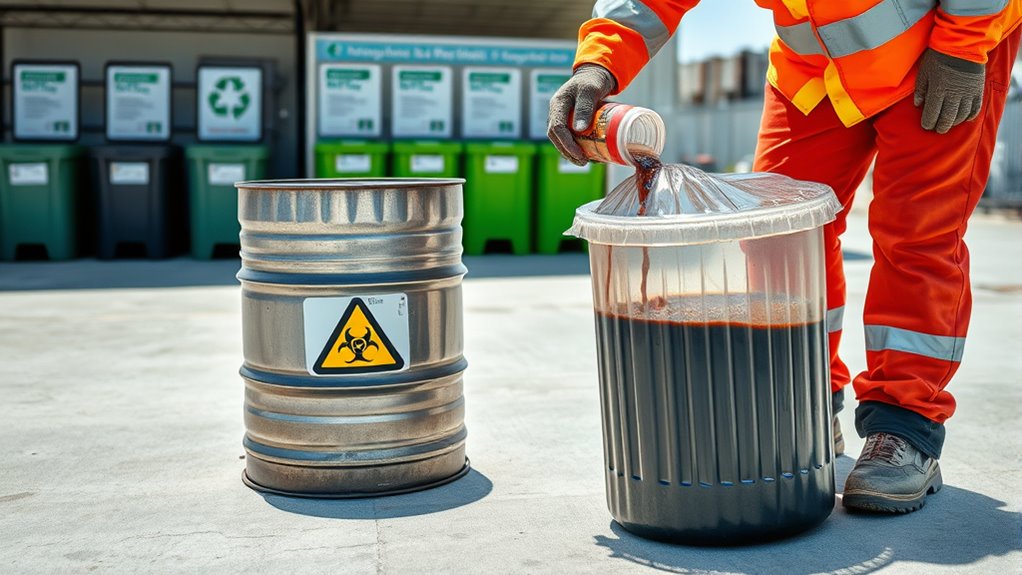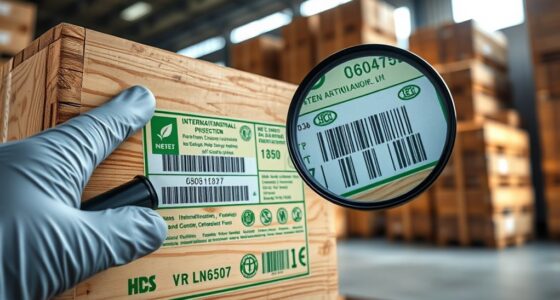To responsibly dispose of used hydraulic fluid, you should store it in labeled, leak-proof containers away from heat and sunlight. Proper collection, on-site treatment, and recycling options help reduce environmental impact and guarantee compliance with laws. Avoid illegal dumping or landfilling, which can harm ecosystems. Partnering with certified waste disposal services and following industry standards keeps you compliant and eco-friendly. If you want to learn more about safe disposal practices, keep exploring the key steps involved.
Key Takeaways
- Properly identify and label used hydraulic fluid as hazardous waste and store it in leak-proof containers with secondary containment.
- Partner with licensed, certified waste disposal facilities to ensure environmentally compliant disposal methods.
- Prioritize recycling and reuse of hydraulic fluid through on-site treatment or professional recycling services.
- Follow all legal regulations and industry standards for waste management, including proper documentation and permits.
- Implement safety measures such as PPE, spill response plans, and regular staff training to prevent health and environmental hazards.
Understanding Hydraulic Fluid Waste
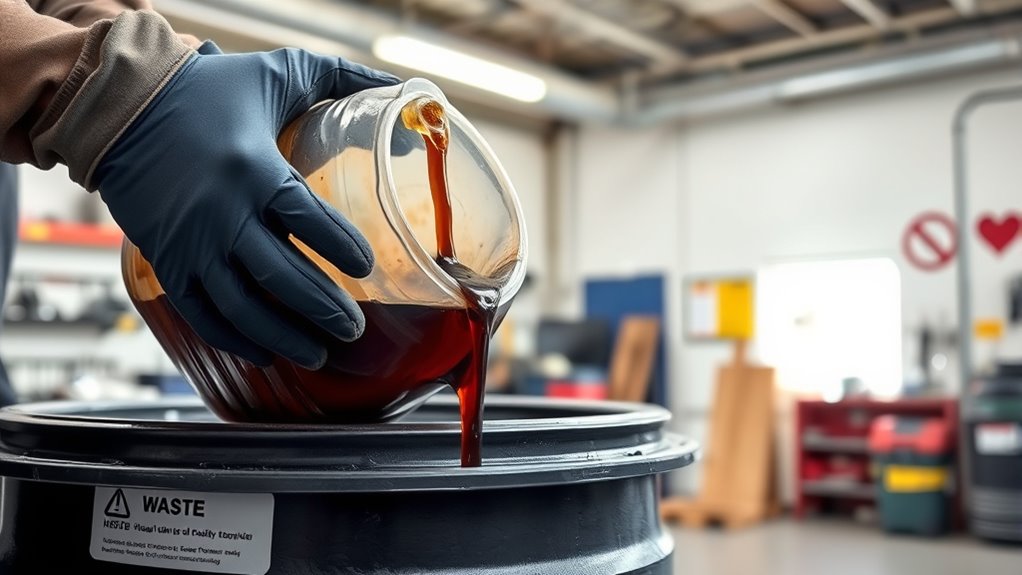
Have you ever wondered what happens to hydraulic fluid once it’s used up? Used hydraulic fluid becomes waste that can harm the environment if not managed properly. Many modern fluids include biodegradable additives, which help break down the fluid more quickly and reduce environmental impact. Still, you need to be cautious, especially with spill containment. Spills can happen during storage, transfer, or disposal, and promptly containing these spills prevents soil and water contamination. Properly identifying and controlling waste helps protect ecosystems and ensures compliance with safety regulations. Handling used fluid with awareness reduces environmental risks and the proper disposal methods are essential for sustainable practices. Additionally, understanding the hazardous nature of waste promotes safer handling and disposal procedures, further minimizing ecological harm. Incorporating proper waste segregation practices ensures that different types of waste are disposed of correctly and safely. Being aware of regulatory requirements can also guide responsible disposal and prevent legal issues.
Why Proper Disposal Matters

Proper disposal of hydraulic fluid helps safeguard the environment from contamination and pollution. It also guarantees you stay compliant with laws that can result in fines if ignored. Additionally, handling used fluid correctly reduces health and safety risks for you and others around you. Being aware of environmental impact as part of your disposal process emphasizes the importance of protecting ecosystems and public health. Understanding the lifecycle of fluids can further enhance responsible disposal practices. Recognizing the importance of vehicle maintenance ensures that all components, including hydraulic systems, are managed properly to prevent leaks and spills, and considering water safety measures can help prevent accidents during disposal.
Environmental Impact Reduction
When used hydraulic fluid is disposed of improperly, it can substantially harm the environment. Different hydraulic fluid formulations contain chemicals that can contaminate soil and water, impacting ecosystems and public health. Proper disposal prevents these harmful substances from leaching into the ground or entering waterways. Conducting a disposal cost analysis helps you choose eco-friendly options that minimize environmental impact while remaining cost-effective. By investing in responsible disposal methods, you reduce the risk of leaks, spills, and illegal dumping that can poison wildlife and degrade natural resources. Proper disposal not only protects the environment but also promotes your company’s sustainability goals. Taking these steps ensures you’re actively reducing your ecological footprint and contributing to a cleaner, healthier planet. Additionally, understanding the noise levels of modern heat pumps can help ensure your heating system operates quietly and efficiently, minimizing disruption to your environment. Being aware of environmental regulations can further guide your disposal practices to stay compliant and environmentally conscious. Implementing proper handling procedures for hydraulic fluids also minimizes the chance of accidental releases, safeguarding ecosystems from potential contamination. Regular training on spill prevention measures can further enhance safety and environmental responsibility. Furthermore, staying informed about merchant service risks can help you better manage financial and cybersecurity threats related to waste disposal logistics.
Legal Compliance Importance
Ensuring the proper disposal of used hydraulic fluid is essential to comply with legal standards and avoid costly penalties. Regulatory agencies have strict rules governing the disposal process, and failure to adhere can lead to significant legal penalties. Proper disposal helps you stay compliant with environmental laws, reducing liability concerns for your business. If you neglect legal requirements, you risk fines, sanctions, or even shutdowns, which can damage your reputation and finances. Knowing and following the law demonstrates your commitment to responsible practices and minimizes your liability concerns. By adhering to proper disposal procedures, you protect your business from legal repercussions and contribute to environmental protection. Incorporating industry standards into your disposal process ensures consistent compliance and promotes best practices. Staying informed about environmental regulations can help you adapt your procedures to any new legal updates. Additionally, understanding hazardous waste management requirements is vital to prevent accidental pollution and ensure safe handling of used fluids, which underscores the importance of proper waste classification in your disposal protocols. Regular staff training on waste handling procedures can further reduce the risk of compliance issues and ensure everyone understands the importance of proper disposal methods.
Health and Safety Risks
Incorrect disposal of used hydraulic fluid can pose serious health and safety risks to workers and the environment. Exposure can cause skin irritation, respiratory issues, or more severe health problems. Proper spill response and wearing personal protective equipment (PPE) are essential to minimize risks. Handling spills quickly prevents contamination and reduces injury chances.
| Risk | Prevention Measures |
|---|---|
| Skin and eye contact | Use gloves, goggles, and PPE |
| Inhalation of fumes | Ensure proper ventilation and masks |
| Environmental contamination | Follow proper disposal procedures |
| Fire hazards | Store away from sparks and heat sources |
Recognizing Hazardous Waste Regulations
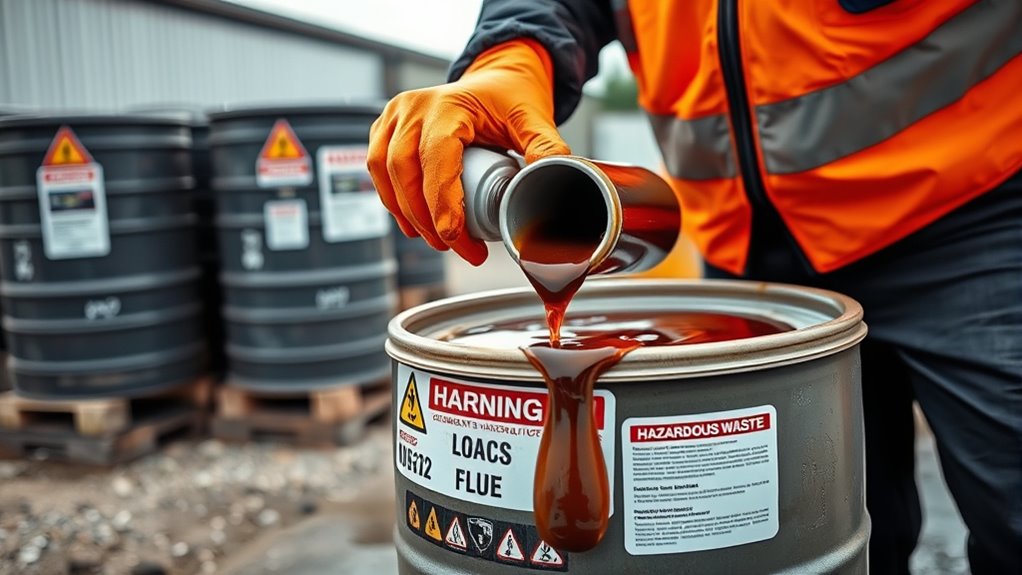
Understanding how used hydraulic fluid is classified as hazardous waste is essential for compliance. You need to know the specific regulations that dictate proper disposal methods. Recognizing these rules helps you avoid penalties and protect the environment. Additionally, proper disposal methods are often outlined in regulatory guidelines, which specify how to handle hazardous waste safely. Being aware of hazardous waste classifications ensures that you follow the correct procedures for disposal. Familiarity with health and safety standards related to hazardous waste management can further safeguard workers and the environment.
Hazardous Waste Classification
Recognizing whether used hydraulic fluid qualifies as hazardous waste is a critical step in proper disposal. You need to understand its hydraulic fluid composition and how it fits into hazardous waste regulations. The classification depends on contaminants like heavy metals or toxic additives. Proper evaluation helps you avoid costly disposal mistakes. Use this table to assess:
| Characteristic | Criteria | Example |
|---|---|---|
| Ignitability | Flash point below 140°F | Used oil with solvents |
| Reactivity | Unstable/reacts violently | Corrosive hydraulic fluid |
| Toxicity | Contains harmful substances | Fluids with heavy metals |
| Corrosivity | pH below 2 or above 12.5 | Acidic hydraulic fluid |
| Ignitability | Flammable or combustible | Old hydraulic oil |
This classification influences your disposal cost analysis and guarantees compliance with regulations.
Regulatory Disposal Requirements
To properly dispose of used hydraulic fluid, you must adhere to specific hazardous waste regulations set by federal and state agencies. These regulations are vital for protecting the environment and your business from penalties. Key requirements include:
- Ensuring proper labeling of the waste, so everyone knows it’s hazardous.
- Securing disposal facility permits before sending waste off-site.
- Using approved disposal facilities that comply with environmental standards.
- Maintaining detailed records to demonstrate compliance during inspections.
Failing to follow these rules can lead to costly fines, legal action, or environmental damage. Recognizing hazardous waste regulations isn’t just about compliance — it’s about responsibility. By understanding and following these requirements, you protect your business, employees, and the planet from unnecessary harm.
Collecting and Storing Used Hydraulic Fluid Safely

Properly collecting and storing used hydraulic fluid is essential to prevent spills, leaks, and environmental contamination. Use appropriate storage containers designed for hazardous liquids—these should be leak-proof, clearly labeled, and made of materials resistant to hydraulic fluid. Always inspect containers regularly for signs of deterioration or damage. To guarantee spill prevention, keep containers on stable, level surfaces and in secondary containment trays to catch any accidental leaks. Seal containers tightly after each use to avoid evaporation or accidental spills. Store hydraulic fluid away from sources of heat and direct sunlight, which can degrade the fluid and compromise container integrity. By following these guidelines, you protect your environment, reduce cleanup risks, and stay compliant with safety standards.
On-Site Treatment and Recycling Options

Once you’ve collected and stored used hydraulic fluid safely, exploring on-site treatment and recycling options helps reduce waste and environmental impact. Implementing innovative recycling methods or on-site treatment systems empowers you to manage used fluid responsibly. Consider these options:
- Invest in on-site filtration systems to remove contaminants efficiently.
- Use mobile treatment units to recycle hydraulic fluid at your location.
- Implement filtration and separation techniques to extend fluid life.
- Adopt advanced recycling technologies to minimize disposal needs.
These approaches enable you to actively reduce hazardous waste, save costs, and promote sustainability. On-site treatment offers immediate control, ensuring your operation remains environmentally responsible. By choosing innovative recycling solutions, you’re not just managing waste—you’re leading in environmental stewardship.
Partnering With Certified Waste Disposal Services
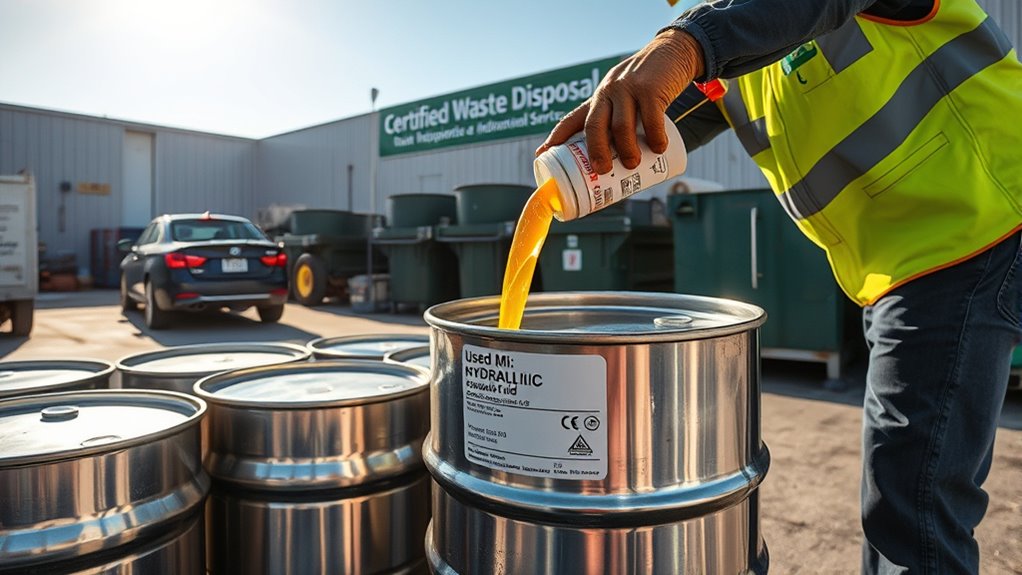
Partnering with certified waste disposal services guarantees your used hydraulic fluid is handled safely and responsibly. They adhere to strict disposal standards and follow proper handling procedures to prevent environmental harm. Choosing experienced professionals also helps you stay aware of the environmental impacts associated with disposal.
Certified Disposal Standards
Have you considered how working with certified waste disposal services can guarantee your used hydraulic fluid is disposed of responsibly? Certified disposal standards ensure your waste meets strict recycling methods and disposal certifications, giving you peace of mind. When you partner with certified providers, you protect the environment and your reputation. Here are four reasons why this matters:
- You prevent environmental contamination, safeguarding communities.
- You comply with legal requirements, avoiding costly penalties.
- You support sustainable recycling methods, reducing waste.
- You demonstrate corporate responsibility, building trust with clients.
Choosing certified disposal services isn’t just about compliance — it’s about making a positive impact and ensuring your hydraulic fluid is managed properly. Trust standards that prioritize safety, environmental care, and accountability.
Proper Handling Procedures
To guarantee safe and compliant disposal of used hydraulic fluid, you must follow proper handling procedures when working with certified waste disposal services. Always wear protective gear, like gloves and goggles, to prevent contact with hazardous fluid. Store used hydraulic fluid in approved containers, clearly labeled for fluid maintenance. When transferring fluid, avoid spills and leaks by using secure connections. Use the table below to guide your handling process:
| Step | Action | Precaution |
|---|---|---|
| 1 | Transfer fluid safely | Ensure containers are sealed |
| 2 | Store in designated area | Keep away from heat or flames |
| 3 | Transport with care | Use proper labeling |
| 4 | Notify disposal service | Confirm compliance standards |
| 5 | Document disposal | Maintain records for reference |
Following these procedures ensures your hydraulic system remains efficient and fluid maintenance stays compliant.
Environmental Impact Awareness
Proper disposal of used hydraulic fluid not only safeguards workplace safety but also minimizes environmental harm. Partnering with certified waste disposal services ensures your actions align with environmental standards and reduces risks. Understanding hydraulic fluid composition helps determine the best disposal methods, preventing leaks or spills that could contaminate soil and water. Conducting a disposal cost analysis allows you to balance expense with environmental responsibility, ensuring sustainable practices.
Consider these critical impacts:
- Preventing toxic substances from entering ecosystems and harming wildlife.
- Avoiding hefty fines and legal consequences for improper disposal.
- Protecting groundwater sources from hydraulic fluid contamination.
- Preserving your company’s reputation by demonstrating environmental accountability.
Environmental Impacts of Improper Disposal
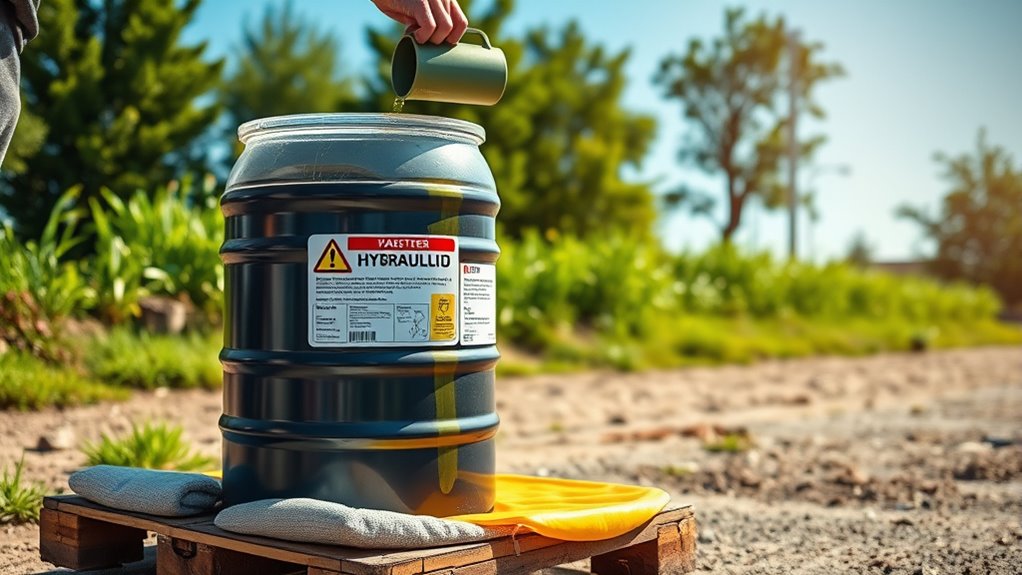
When hydraulic fluid is disposed of improperly, it can pose serious threats to the environment. Spilled fluid can contaminate soil and water, harming plants, animals, and even human health. Toxic chemicals in the fluid may persist, making cleanup costly and complex. Considering hydraulic fluid alternatives, like biodegradable options, can reduce environmental risks. Conducting a disposal cost analysis helps you identify affordable and eco-friendly methods. Here’s a quick comparison:
| Disposal Method | Environmental Impact | Cost Effectiveness |
|---|---|---|
| Landfill Disposal | High risk of groundwater contamination | Low |
| Incineration | Releases pollutants, costly | Moderate |
| Recycling & Reuse | Minimal environmental impact | Cost-efficient |
Choosing responsible disposal methods protects ecosystems and aligns with sustainability goals.
Best Practices for Disposal in Different Industries
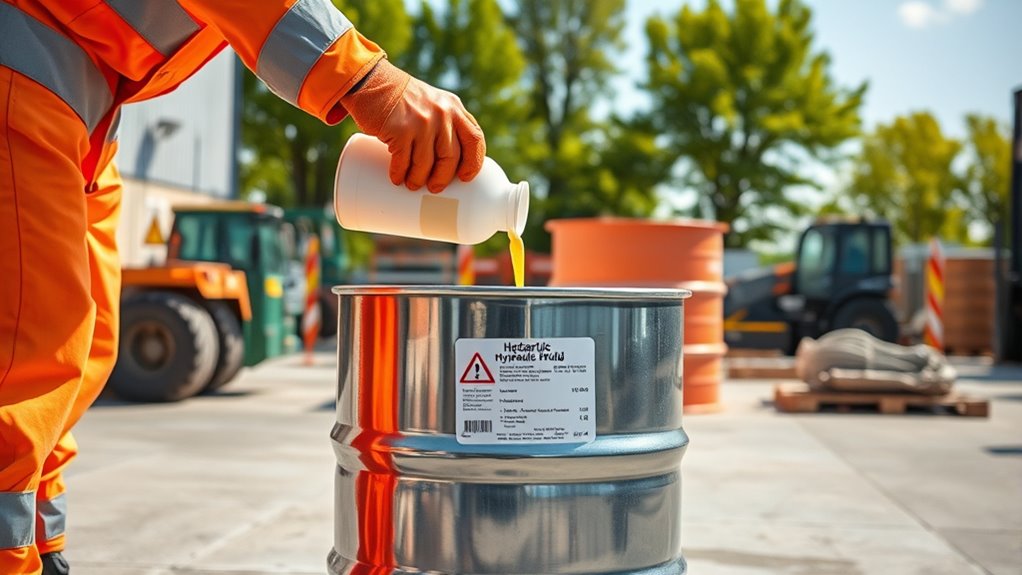
Different industries have unique requirements and regulations that influence how they dispose of used hydraulic fluid. Understanding industry-specific disposal practices helps protect the environment and maintain compliance. To guarantee responsible management, consider these best practices:
- Prioritize hydraulic fluid recycling whenever possible to reduce waste and conserve resources.
- Follow industry-specific disposal guidelines to meet legal standards and avoid penalties.
- Partner with certified waste management companies experienced in industry-specific disposal methods.
- Regularly train staff on proper handling and disposal procedures to prevent costly mistakes.
Educating Employees on Hazardous Waste Management
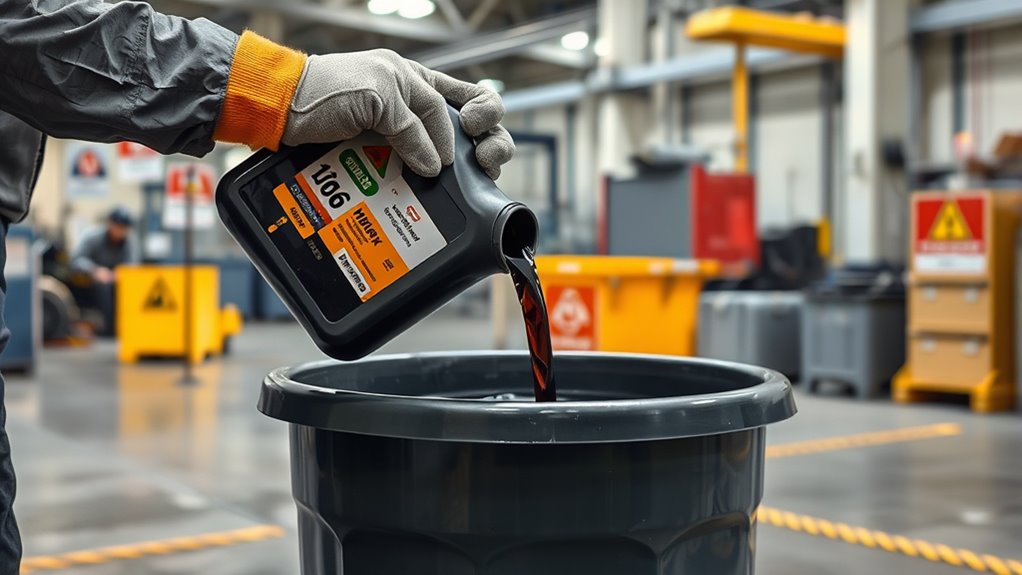
Effective employee training is vital to ensuring used hydraulic fluid is managed safely and in compliance with regulations. When training staff, emphasize understanding hydraulic fluid composition, including identifying contaminants that may increase disposal risks. Educate employees on proper handling procedures, spill prevention, and the importance of segregation to reduce hazards. Highlight how knowledge of disposal cost analysis can influence decision-making, encouraging cost-effective and environmentally responsible practices. Employees should recognize the significance of labeling and storing used hydraulic fluid correctly to prevent leaks and contamination. Regular training updates promote awareness of evolving regulations and best practices, helping your team stay compliant. Well-informed employees are key to minimizing environmental impact, controlling disposal costs, and maintaining a safe workplace.
Staying Compliant With Local and National Laws
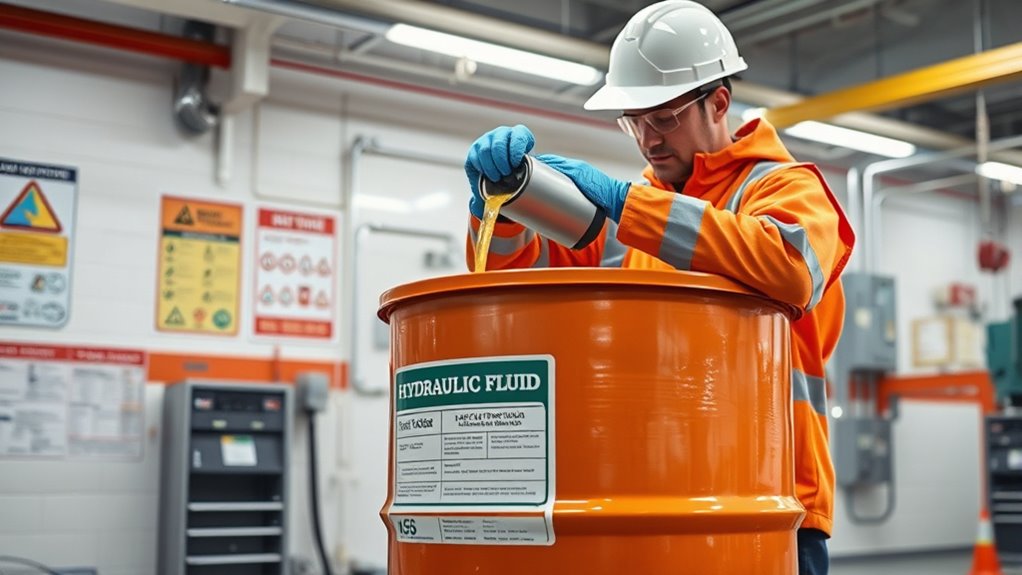
Staying compliant with local and national laws is essential for responsible used hydraulic fluid disposal. Ignoring regulations can lead to hefty fines, environmental harm, and damage to your reputation. To guarantee compliance, focus on these key steps:
- Choose proper disposal site selection—only work with licensed facilities that handle hydraulic fluid recycling.
- Understand your jurisdiction’s regulations—keep updated on legal requirements for hazardous waste management.
- Maintain detailed records—document disposal activities to prove compliance during inspections.
- Prioritize environmentally safe options—recycling hydraulic fluid reduces waste and supports sustainability.
Frequently Asked Questions
How Can I Identify if Hydraulic Fluid Is Contaminated?
To identify if hydraulic fluid is contaminated, start by conducting fluid testing, which reveals contamination signs like unusual color, cloudiness, or sediment. You might notice increased wear, strange noises, or decreased system performance, indicating possible contamination. Regularly inspecting the fluid and performing tests helps catch issues early, preventing system damage. If you see these signs, it’s time to test your hydraulic fluid to confirm contamination and take appropriate corrective actions.
Are There Specific Disposal Methods for Biodegradable Hydraulic Fluids?
When it comes to biodegradable hydraulic fluids, you need to follow specific disposal guidelines. These alternatives are designed to be environmentally friendly, but improper disposal can still cause harm. You should guarantee that used biodegradable fluids are collected separately, stored properly, and disposed of at authorized facilities. Always check local regulations, use designated disposal services, and prioritize recycling whenever possible to protect the environment and comply with safety standards.
What Are the Costs Associated With Professional Disposal Services?
When considering professional disposal services, you’ll find costs vary based on factors like fluid volume and location. It’s wise to do a cost comparison among different service providers to guarantee you get the best deal. Typically, service providers charge based on the amount of used hydraulic fluid you need to dispose of, and some may include pickup, treatment, and recycling fees. Always ask for detailed quotes to avoid surprises.
Can Used Hydraulic Fluid Be Safely Reused or Repurposed?
You can consider fluid recycling to reuse hydraulic fluid, but be aware of reuse challenges like contamination and degradation. Reusing or repurposing hydraulic fluid requires careful testing to make certain it still meets performance standards. While some filtered and cleaned fluid can be recycled, it’s vital to evaluate its condition thoroughly. Recycling helps reduce waste and costs, but only if the fluid passes the necessary quality checks for safe reuse.
How Often Should Hydraulic Fluid Disposal Procedures Be Reviewed or Updated?
You should review and update your hydraulic fluid disposal procedures regularly, at least annually, to guarantee safety and efficiency. Incorporate these updates into your maintenance schedules to stay on top of best practices. This approach helps you maintain regulatory compliance, prevent environmental harm, and avoid costly penalties. By proactively managing disposal procedures, you ensure your operations remain responsible, compliant, and aligned with evolving industry standards.
Conclusion
By properly disposing of used hydraulic fluid, you protect the environment like a vigilant guardian and keep your operations compliant. Remember, each step you take is a brushstroke in the bigger picture of sustainability. Stay informed, follow regulations, and educate your team—your responsible actions guarantee that hazardous waste doesn’t become a ticking time bomb. Together, you can turn a potential disaster into a beacon of eco-friendly stewardship, safeguarding tomorrow’s world today.
